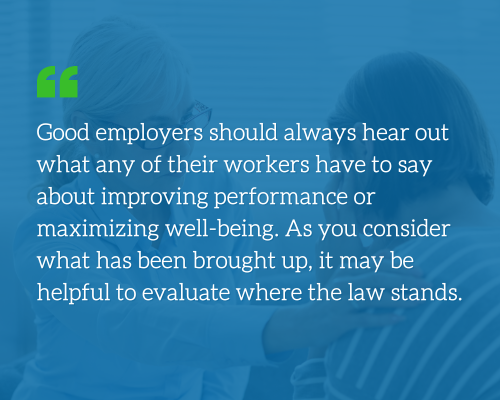ADA reasonable accommodation checklist
 The Americans with Disabilities Act (ADA) helps people with disabilities receive the same rights and equal opportunity as everyone else. At the heart of the ADA, as it pertains to employment, is a section known as Title I. Title I presents two key issues. First, the act prohibits private employers, state and local governments, employment agencies, and labor unions from discriminating against qualified individuals with disabilities in applying for jobs, hiring, firing, and job training. Second, it requires covered employers to provide reasonable accommodations for applicants and employees with disabilities. The U.S. Equal Employment Opportunity Commission (EEOC) enforces Title I of the ADA.
The Americans with Disabilities Act (ADA) helps people with disabilities receive the same rights and equal opportunity as everyone else. At the heart of the ADA, as it pertains to employment, is a section known as Title I. Title I presents two key issues. First, the act prohibits private employers, state and local governments, employment agencies, and labor unions from discriminating against qualified individuals with disabilities in applying for jobs, hiring, firing, and job training. Second, it requires covered employers to provide reasonable accommodations for applicants and employees with disabilities. The U.S. Equal Employment Opportunity Commission (EEOC) enforces Title I of the ADA.
Putting the goals of the Americans with Disabilities Act into action sometimes proves confusing for employers. They may struggle with the definition of “reasonable accommodations” or who exactly qualifies for assistance.
The following offers general guidelines for employers as they go through the interactive process of developing effective accommodations as situations necessitate. As individual circumstances often influence actions and decisions, consult legal counsel for specific questions.
ADA reasonable accommodation checklist:
Item 1: Receive notification
Typically, an employee with a disability initiates the accommodations discussion either with management or human resources. She comes forth with a suggestion for a change or modification that would allow her to do her job better.
The employer should take what is said seriously and consider the request as the formal start of the interactive process. It also is a good time to start documenting the situation in case questions arise later as to what was said or done.
In some cases, a manager becomes aware of the possible need for an accommodation through direct observation or through a third party. Sometimes, the issue of accommodation comes up because the employee has exhausted workers’ compensation leave, FMLA (Family and Medical Leave Act) leave, or a similar covered leave but will have difficulty coming back to her job without some changes.
Item 2: Determine eligibility
Good employers should always hear out what any of their workers have to say about improving performance or maximizing well-being. However, being presented with an idea does not automatically mean an organization is compelled to agree with what someone suggests. As you consider what has been brought up, it may be helpful to evaluate where the law stands.
For starters, know whether or not your company is subject to the ADA. Businesses with fewer than 15 employees are not covered by the employment provisions of the ADA, but state or local laws may lower that number.
Next, think about whether or not the person is covered by the ADA. According to the United States Department of Justice Civil Rights Division’s ADA.gov, “To be protected by the ADA, one must have a disability, which is defined by the ADA as:
- a physical or mental impairment that substantially limits one or more major life activities
- a person who has a history or record of such an impairment
- a person who is perceived by others as having such an impairment.”
In some cases, the presence of an employee’s disability is clear. When a disability or the need for an accommodation is not obvious, an employer can require sufficient documentation of the employee’s disability from a health care provider. But tread carefully if asking for proof. Limit your request to medical documentation that is sufficient to substantiate an ADA disability and the need for the requested accommodation. Do not ask for unrelated medical information.
Item 3: Examine the definition of “reasonable” and of “undue hardship”
Employers sometimes fear the idea of disability accommodations. They worry the measure will cost too much or prove too difficult to carry out. But in actuality, many effective accommodations are easy to implement. In fact, the Job Accommodation Network (JAN), a service from the U.S. Department of Labor’s Office of Disability Employment Policy, notes that 58 percent of accommodations cost absolutely nothing to make. The rest typically cost only $500, and tax incentives are available to help employers cover costs.
According to ADA National Network, some common types of accommodations include:
 Modifying job duties.
Modifying job duties.- Providing reserved parking.
- Improving accessibility in a work area.
- Changing the presentation of tests and training materials, such as offering large print or braille.
- Providing or adjusting a product, equipment, or software.
- Allowing a flexible work schedule.
- Providing an aid or a service to increase access.
- Reassignment to a vacant position.
- Allowing a service animal.
If an employer has qualms, it pays to think about ADA terminology before arriving at a decision. First, evaluate whether what the worker wants is a reasonable accommodation. According to the DOL, a reasonable accommodation “is a modification to a job, work environment or the way work is performed that allows an individual with a disability to apply for a job, perform the essential functions of the job, and enjoy equal access to benefits available to other individuals in the workplace.”
The aim is to provide the person what she needs to do her job, not grant “special” privileges that have nothing to do with accommodating a disability. Likewise, the EEOC notes that “an employer never has to reallocate essential functions as a reasonable accommodation, but can do so if it wishes.” Thus, someone should not be asking for job restructuring that changes the heart of her job description. Requesting to switch/eliminate certain marginal tasks or perform them in a different way, however, is within the scope of ADA consideration.
Next, consider the definition of “undue hardship.” The DOL explains this term as “an action requiring significant difficulty or expense when considered in light of factors such as an organization’s size, financial resources, and the nature and structure of its operation.” Covered employers do not have to provide a reasonable accommodation that would cause an undue hardship.
Item 4: Engage in the interactive process
When an employer decides to grant a request for a disability accommodation, the employee, management, and human resources should all sit down and hammer out the exact terms in writing. This document provides proof of the agreement and a point of reference in case questions later arise. Follow up periodically to discuss the effectiveness of the accommodation measures, and adjust as needed.
An employer wishing to deny a request because it appears unreasonable or seems like it would cause an undue hardship should proceed with caution. JAN offers free consulting services for both private and governmental employers. Trained staff can help verify if you’re within your rights to deny the accommodation request. They also can provide alternate possible accommodation ideas that may result in a satisfactory resolution.
Talk with the employee in question about modifications to the initial accommodation request. Stay respectful throughout the interactive process, and look for a solution with which both of you can be comfortable. As always, document conversations and results. Showing a history of trying to work with the person is vital if the matter ever ends up reaching a legal stage.





